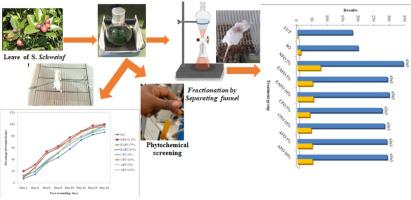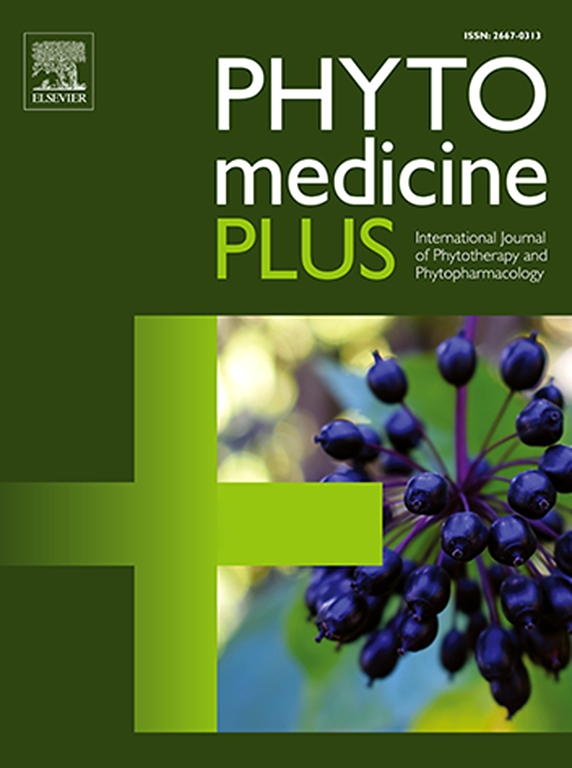Acokanthera schimperi Schweinf(天南星科植物)叶片溶剂馏分的伤口愈合活性和粗提取物及溶剂馏分的抗炎活性在小鼠模型中的应用
Q3 Pharmacology, Toxicology and Pharmaceutics
引用次数: 0
摘要
背景在埃塞俄比亚,Acokanthera schimperi 经常被用来治疗伤口和其他疾病。尽管文献中已有关于粗提取物愈合伤口能力的报告,但迄今为止还没有关于五味子叶抗炎性能或溶剂馏分愈合伤口效果的任何报道。Schimperi 叶 80% 甲醇提取物及其馏分在小鼠体内的伤口愈合能力和抗炎特性。然后将提取物馏分与简单的软膏基质混合,制成5%和10% w/w的软膏。接下来,利用切除和切口伤口模型,对软膏促进伤口愈合的能力进行了评估。切除模型用于估算伤口收缩和上皮化时间,而切口模型则用于测量拉伸强度。将 1% 角叉菜胶溶解在 0.9% 生理盐水(w/v)中,口服粗提取物和溶剂馏分(100、200 和 400 mg/kg),在角叉菜胶诱导的后爪水肿模型中同时评估叶片的抗炎功效。结果在两种模型中,使用 5 % 和 10 %(重量比)溶剂馏分软膏处理的伤口都具有显著的伤口愈合活性,表现为组织断裂强度更高(10 %(重量比)乙酸乙酯馏分软膏的最大效果为 51.38%),上皮化时间更短(10 % 乙酸乙酯馏分软膏的上皮化时间为 15.92 天),伤口收缩率更高(10 % 乙酸乙酯馏分软膏的收缩率为 99.40%)。该研究结果表明,该植物叶片的溶剂馏分可促进伤口愈合,至少部分是通过其抗炎作用实现的。本文章由计算机程序翻译,如有差异,请以英文原文为准。

Wound-healing activity of solvent fractions and antiinflammatory activity of crude extract and solvent fractions of Acokanthera schimperi Schweinf (Apocynaceae) leaves in mice model
Background
In Ethiopia, Acokanthera schimperi is frequently used to treat wounds and other conditions. Nothing has been published to date on the anti-inflammatory properties of A. schimperi leaves or the wound-healing effects of solvent fractions, despite a report on the crude extract's ability to heal wounds being available in the literature.
Purpose
Therefore, this experiment has been initiated to look into the solvent fractions' ability to heal wounds and the anti-inflammatory properties of the A. schimperi leaf 80 % methanol extract and its fractions in mice.
Study design
The experimental study design was conducted to evaluate wound healing and the anti-inflammatory properties of the A. schimperi leaf 80 % methanol extract and its fractions in mice.
Methods
The plant's leaf crude extract was fractionated using ethyl acetate, chloroform, and distilled water. The resulting fractions were then combined with a simple ointment base to make an ointment at 5 % and 10% w/w. Next, using excision and incision wound models, the ointments' ability to promote wound healing was assessed. The excision model was utilized to estimate wound contraction and epithelization time, whereas the incision model was utilized to measure tensile strength. By dissolving 1 % carrageenan in 0.9 % saline (w/v) and giving oral dosages of the crude extract and solvent fractions (100, 200, and 400 mg/kg), the anti-inflammatory efficacy of the leaves was assessed concurrently with a carrageenan-induced hind paw edema model.
Results
Significant wound healing activity was seen in both models in wounds treated with 5 % and 10 % (w/w) solvent fraction ointment, as shown by higher tissue breaking strength (with 51.38 % maximum effect by 10 % (w/w) ethyl acetate fraction ointment), shorter epithelization times (within 15.92 days by ethyl acetate fraction ointment 10 %), and increased wound contraction (99.40 % by ethyl acetate fraction ointment 10 %). The extract (hydromethanolic) and solvent fractions also showed notable dose-related decreases in inflammation.
Conclusion
The study's findings supported A. schimperi's traditional use as a wound healing agent by showing that the solvent fractions of the plant's leaves promoted wound healing, at least in part, through their anti-inflammatory effect.
求助全文
通过发布文献求助,成功后即可免费获取论文全文。
去求助
来源期刊

Phytomedicine Plus
Medicine-Complementary and Alternative Medicine
CiteScore
3.70
自引率
0.00%
发文量
178
审稿时长
81 days
期刊介绍:
 求助内容:
求助内容: 应助结果提醒方式:
应助结果提醒方式:


